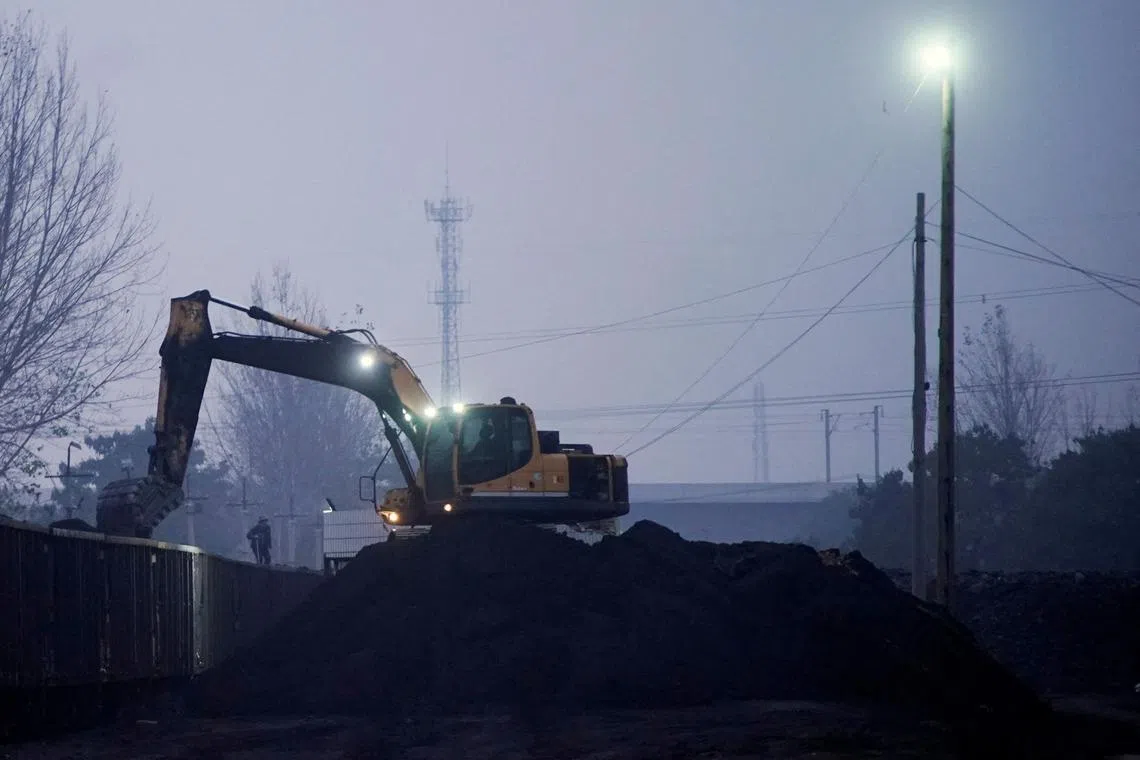China announces plan to curb rising methane emissions but challenges await
Sign up now: Get ST's newsletters delivered to your inbox

Around 40 per cent of China’s methane emissions are gas that escapes during the mining of coal.
PHOTO: REUTERS
Follow topic:
SHANGHAI - China has drafted a new plan to control methane and will promote new technologies and financing mechanisms to slash rising emissions of the greenhouse gas that traps 80 times more heat than carbon dioxide, the country’s top climate official said.
Senior climate change envoy Xie Zhenhua said on the sidelines of climate talks in Egypt’s Sharm El Sheikh on Tuesday that the new action plan would lead to concrete measures to curb methane emissions from energy, agriculture and waste.
Tackling methane has become a major part of global efforts to limit temperature rises to 1.5 deg C.
China’s emissions are the highest in the world and around a fifth of the global total. While it did not sign a “Global Methane Pledge” last year, it agreed to “develop additional measures” to control the gas.
Provincial governments in China have also pledged in recent weeks to take stronger action to curb emissions, and a pilot national programme will begin early next year to discover “best practices” to control and monitor the gas.
But Mr Xie said China’s ability to control the gas remained “weak” and its current focus was on “preliminary goals” like improving monitoring capabilities.
Researchers have warned that China’s emissions profile could make abatement costlier and more difficult than elsewhere.
Unlike the United States, where oil and gas is the major source, around 40 per cent of China’s methane emissions is gas that escapes during the mining of coal, according to the Innovative Green Development Programme (IGDP), a Chinese think-tank.
Another 42 per cent is from agriculture, including livestock and rice cultivation, the IGDP said in a June research report.
“Many of the methane sources are fugitive emissions, which are usually difficult to accurately account for,” said Assistant Professor Zhang Yuzhong, a researcher at China’s Westlake University.
Climate envoy Xie said a “change of thinking” was required to consider greenhouse gases like methane as a potential resource to be utilised.
The utilisation of coalbed methane (CBM) has already become a major industry in China and helped cut atmospheric emissions in northern China’s Shanxi province, which produces as much methane from its mines as the rest of the world combined, according to research by Global Energy Monitor.
Methane concentrations vary dramatically, however, meaning there is no one-size-fits-all technological solution, and no guaranteed financial return to justify building storage infrastructure at every mine, experts say.
Utilisation is also not a practical solution for China’s abandoned coal mines, now responsible for more man-made methane emissions per year than any single industrialised nation apart from the United States and Russia, according to research from China’s Zhejiang University published this month.
Raising utilisation rates could help slash emissions from livestock though, with farmers already encouraged to install digesters to utilise biogas. China’s “comprehensive utilisation” of agricultural waste could also help slash methane emissions.
A bigger challenge is cutting emissions from rice paddies, which breed methane-emitting bacteria. Any solution would require changes in the practices of millions of farmers, said Westlake University’s Zhang.
China’s efforts to control methane have so far come up short and it still has a lot to do, said Global Energy Monitor’s Ryan Driskell Tate, who has researched China’s methane emissions.
“China will need enforcement mechanisms and plans for implementation to achieve its targets,” he said.
China has, meanwhile, set 2030 as the date for peaking carbon emissions for building materials.
Although that aligns with the nationwide target, as recently as September the cement industry had proposed maxing its carbon footprint by 2023, while the building materials sector as a whole would reach its peak by 2025.
It follows a similar retreat in the steel industry’s carbon goals, and plans for a massive expansion in coal-fired power generation.
Building materials are the No. 3 emitter after power and steel. China’s cement industry alone is responsible for as much carbon as the whole of India’s energy production, according to BP data. Just as China continues to prioritise coal to meet its energy security needs, the best explanation for the scaled-back ambition is economic: Beijing wants to create enough headroom to allow the kind of massive spending on public works that it has deployed before to bolster its economy.
“The industries can only deliver a peak once Beijing stops using construction stimulus to prop up GDP,” Dr Lauri Myllyvirta, lead analyst at the Centre for Research on Energy and Clean Air, said on Twitter.
The new deadline is somewhat confounding because infrastructure spending over time has become less reliant on cement and steel as the economy has evolved. Moreover, China is already on course for its second successive year of lower steel output, mandated by the government to control emissions, while the crackdown on the property market that began last year is a deliberate policy of shrinking the sector’s outsized influence on the economy.
BLOOMBERG, REUTERS

